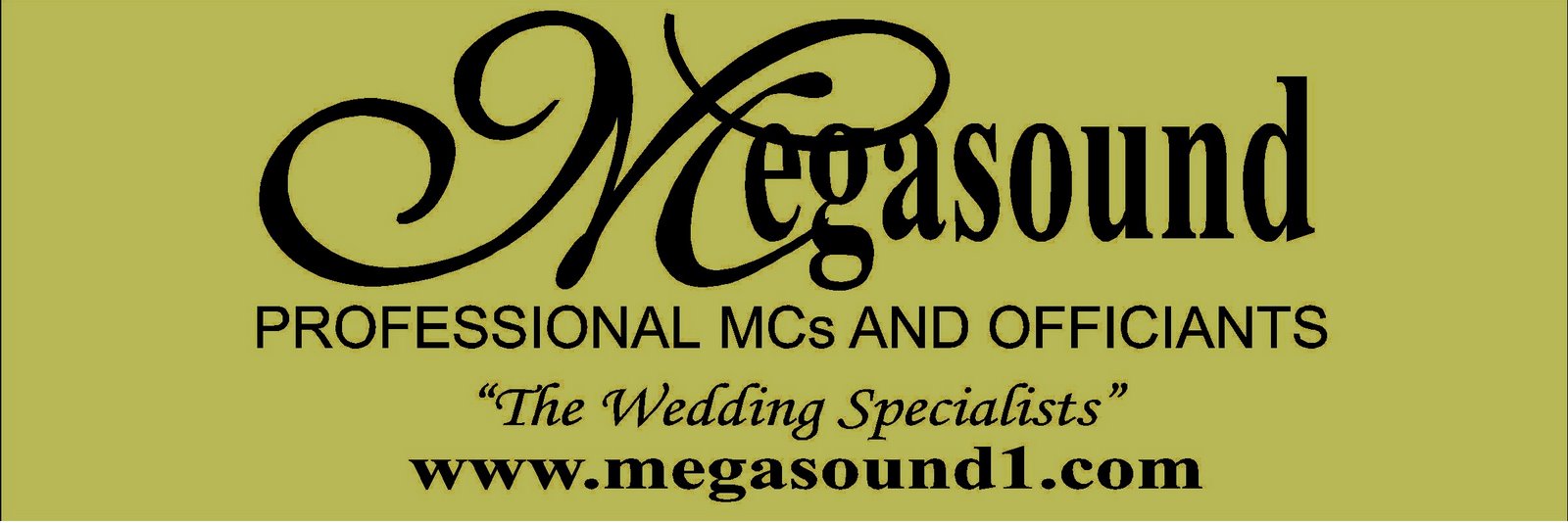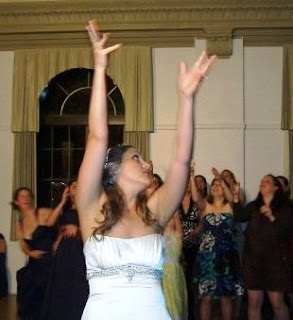From Erik Michaels and June Hoffman of Megasound
Like many of today's wedding traditions, the bouquet toss also originated in Europe during medieval times. Surprisingly to many people, this custom is more closely related to the “Garter Throw” than many would believe. Back in those times, most brides would not wear their dress again, and the dress was considered to be good luck for other women to wear as a sort of fertility charm.
After the wedding, single women would chase the bride and rip pieces of her dress off, leaving her in tatters. Wedding dresses became far more expensive over time and it became traditional for women to keep them as a memento or to pass on to a daughter for her wedding day.
To prevent guests from ripping the wedding dress, brides began throwing other objects as a distraction; one of which was the garter. Later, the bouquet became the most traditionally thrown object. The wedding bouquet is particularly suited to this use, as flowers symbolize fertility; and as perishable items, they are not something the bride would wish to keep. The bouquet is also a safer item to toss than the garter, as unruly and impatient wedding guests were sometimes known to try to take the garter from the bride while she was still wearing it.
Today, some brides and grooms do not like the tradition of throwing the bouquet and either modify it or do away with it completely. Tossing the bouquet can be uncomfortable for unmarried female guests who do not wish to marry or who feel "put on the spot" by the custom. Also, competition to catch the bouquet can become a violent stampede. Some brides stage the event so that their maid of honor or a friend who is engaged catches the bouquet. Others choose to give a small bouquet to each of their bridesmaids, or to give each woman at the reception a flower from the bridal bouquet.
The Megasound staff works with each bridal couple ahead of time to determine if the bouquet toss is a tradition that they want to incorporate in their wedding reception. We offer many tasteful song suggestions as well. Give us a call for your complimentary consultation so you can find out firsthand how Megasound will assist you with your wedding.
Friday, January 29, 2010
Thursday, January 28, 2010
Is Toasting at a Wedding, Really About Bread?
From Erik Michaels and June Hoffman of Megasound
Toasting is a tradition which comes to us from the ancient French custom of placing bread in the bottom of a glass. Historically, a person who is good at toasting would drink all of the beverage to get to the "toast" at the bottom of the glass. Of course, today we propose toasts to all sorts of things; not just wedding couples. Toasts come with all sorts of legends, just like other traditions and rituals. One such legend has it that when a bride and groom drink their beverage for their toast, whoever finishes their drink first will rule the family.
While many people prefer to come up with their own original toast, there are prepared toasts which can also be used. A good practice for toasts is to focus on positive aspects although we have definitely heard our fair share of embarrassing stories over the years. Some of these stories can actually be quite hilarious; however, it is still a good idea to keep the stories in good taste.
We, at Megasound, have assisted many wedding party members and parents as well as brides and grooms with how to prepare and present wedding toasts. To learn more about our MC skills and how we help with fun and meaningful toasting, just give us a call at 260-484-2460. "Cheers to YOU!!"
Toasting is a tradition which comes to us from the ancient French custom of placing bread in the bottom of a glass. Historically, a person who is good at toasting would drink all of the beverage to get to the "toast" at the bottom of the glass. Of course, today we propose toasts to all sorts of things; not just wedding couples. Toasts come with all sorts of legends, just like other traditions and rituals. One such legend has it that when a bride and groom drink their beverage for their toast, whoever finishes their drink first will rule the family.
While many people prefer to come up with their own original toast, there are prepared toasts which can also be used. A good practice for toasts is to focus on positive aspects although we have definitely heard our fair share of embarrassing stories over the years. Some of these stories can actually be quite hilarious; however, it is still a good idea to keep the stories in good taste.
We, at Megasound, have assisted many wedding party members and parents as well as brides and grooms with how to prepare and present wedding toasts. To learn more about our MC skills and how we help with fun and meaningful toasting, just give us a call at 260-484-2460. "Cheers to YOU!!"
Wednesday, January 27, 2010
Why is the Wedding Ring Finger the Third Finger of the Left Hand?
From Erik Michaels and June Hoffman of Megasound
Last month, June and I wrote about all kinds of wedding-related items to celebrate the holiday season with 25 days of information. For us, there was another significance to the 25 days; as Megasound is celebrating its 25th anniversary this year.
As another way to celebrate being in business for 25 years this month, we will be writing another series of 25 articles. These 25 articles will focus on the history of different wedding traditions and rituals. We believe that history serves as a reminder of the roots of tradition and we find it fascinating. We hope that you, too, will find the history of these different wedding traditions exciting and interesting as we will also add in touches on how current trends are reflective of this history. If there is a tradition that you want to learn more about, please contact us!
In ancient times, it was believed that there was a vein in the third finger of the left hand that ran directly to the heart. With the ring being placed on that finger, this denoted the strong connection of a heartfelt love and commitment to one another. Despite modern knowledge that this long held belief is not true, the tradition has continued to this day.
Medieval grooms placed the ring on three of the bride's fingers, in turn, to symbolize, God the Father, God the Son and God the Holy Spirit. The ring then remained on the third finger and has become the customary ring finger for English-speaking cultures. In some European countries, the ring is worn on the left hand before marriage, and is moved to the right hand during the ceremony.
However, in most European countries, the ring is still worn on the bride's left hand. A Greek Orthodox bride wears her ring on her left hand before marriage, and moves it to her right hand after the ceremony.
Modern tradition has it so that just one ring - the engagement ring - is worn before the wedding ceremony. A second ring is added during the ceremony; the wedding ring. The significance of the wedding ring is also generally explained as a part of most wedding ceremonies to describe the symbolism of wearing such a ring.
YOUR Wedding Ceremony - The ring exchange element may be abbreviated to fit into shorter timelines. This part of your ceremony is a visual representation of your commitment to your partner. Don’t panic if the ring does not fit or if a ring is forgotten. Simply keep going and remember that you are still married and can fix the ring later.
Our experienced staff and our Officiants work closely with our brides and grooms to create a meaningful wedding ceremony. If you have questions about including personalized ring exchange vows, give Megasound a call at 240-484-2460.
Last month, June and I wrote about all kinds of wedding-related items to celebrate the holiday season with 25 days of information. For us, there was another significance to the 25 days; as Megasound is celebrating its 25th anniversary this year.
As another way to celebrate being in business for 25 years this month, we will be writing another series of 25 articles. These 25 articles will focus on the history of different wedding traditions and rituals. We believe that history serves as a reminder of the roots of tradition and we find it fascinating. We hope that you, too, will find the history of these different wedding traditions exciting and interesting as we will also add in touches on how current trends are reflective of this history. If there is a tradition that you want to learn more about, please contact us!
In ancient times, it was believed that there was a vein in the third finger of the left hand that ran directly to the heart. With the ring being placed on that finger, this denoted the strong connection of a heartfelt love and commitment to one another. Despite modern knowledge that this long held belief is not true, the tradition has continued to this day.
Medieval grooms placed the ring on three of the bride's fingers, in turn, to symbolize, God the Father, God the Son and God the Holy Spirit. The ring then remained on the third finger and has become the customary ring finger for English-speaking cultures. In some European countries, the ring is worn on the left hand before marriage, and is moved to the right hand during the ceremony.
However, in most European countries, the ring is still worn on the bride's left hand. A Greek Orthodox bride wears her ring on her left hand before marriage, and moves it to her right hand after the ceremony.
Modern tradition has it so that just one ring - the engagement ring - is worn before the wedding ceremony. A second ring is added during the ceremony; the wedding ring. The significance of the wedding ring is also generally explained as a part of most wedding ceremonies to describe the symbolism of wearing such a ring.
YOUR Wedding Ceremony - The ring exchange element may be abbreviated to fit into shorter timelines. This part of your ceremony is a visual representation of your commitment to your partner. Don’t panic if the ring does not fit or if a ring is forgotten. Simply keep going and remember that you are still married and can fix the ring later.
Our experienced staff and our Officiants work closely with our brides and grooms to create a meaningful wedding ceremony. If you have questions about including personalized ring exchange vows, give Megasound a call at 240-484-2460.
Labels:
wedding ceremony,
wedding ring,
wedding symbolism
Subscribe to:
Comments (Atom)








